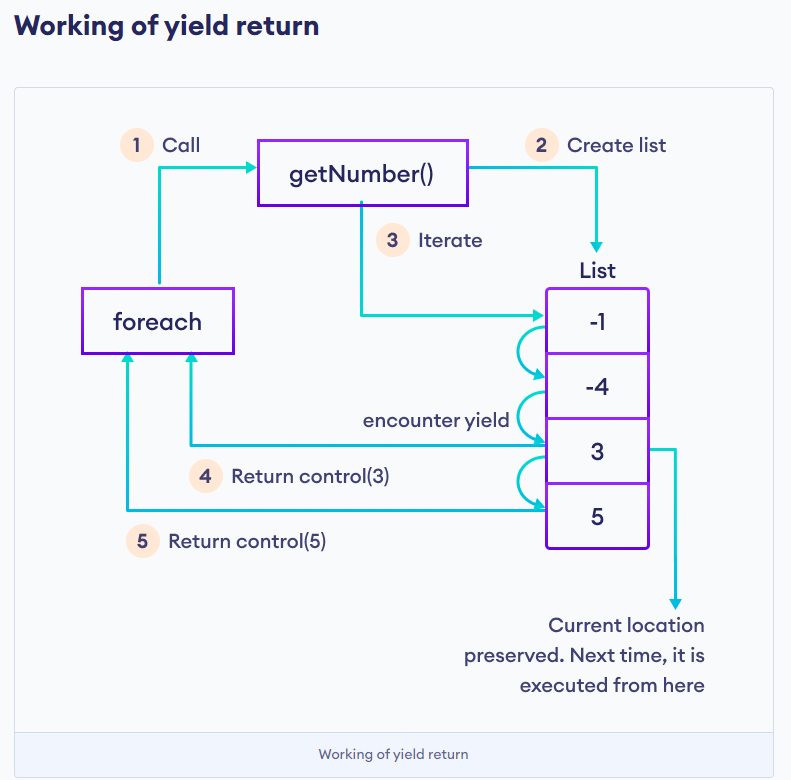https://www.programiz.com/csharp-programming/yield-keyword
The yield keyword performs custom iteration over a collection like list, array, etc.
Two Forms of yield Keyword
The yield keyword is used in two forms:
yield return- returns an expression at each iterationyield break- terminates the iteration
yield return in an Iterator
The yield keyword is used in an iterator as:
yield return <expression>;
We use yield return inside an iterator as:
using System;
using System.Collections.Generic;
class Program
{
// define an iterator method
static IEnumerable<int> getNumber()
{
// create a list of integers
List<int> myList = new List<int> { -1, -4, 3, 5 };
foreach (var num in myList)
{
// returns positive number from myList
if (num >= 0)
{
yield return num;
// location of the code is preserved
// so on the next iteration getNumber() is executed from here
Console.WriteLine("....");
}
}
}
static void Main()
{
// display return values of getNumber()
foreach (var items in getNumber())
{
Console.WriteLine(items);
}
}
}Output
3
....
5
....In the above example, we have created an iterator method getNumber() inside which we have used yield return.
Here, when getNumber() is called from foreach of Main(), the code inside getNumber() is executed until it reaches yield return.
When it reaches yield return, the current location of the code is preserved and the control goes back to the caller(i.e. foreach loop) and 3 is printed.
In the next iteration of foreach, the getNumber() method is called again. This time, getNumber() is executed from the preserved location of the code. This means,
Console.WriteLine("....");
gets executed and getNumber() resumes until it encounters another yield return and the same process continues till iterating over myList is completed.
Let’s discuss the working of the above program with the help of an image.

1. foreach calls getNumber() - At first, the code inside the Main() function gets executed. Inside Main(), we have created a foreach loop that calls getNumber() method.
-
Inside
getNumber(),myListis created. -
Then, the
foreachloop insidegetNumber()starts iterating overmyList. Notice the code,
if (num >= 0)
{
yield return num;
// location of the code is preserved
// so on the next iteration getNumber() is executed from here
Console.WriteLine("....");
}When num = 3, num >= 0 returns True and yield return is encountered. Two operations occur:
- pauses
getNumber()and preserves the current location of the code - control goes back to the
foreachloop (caller)
- Control goes back to the caller - Here, the returned value 3 is printed and the next iteration of
foreachbegins.
In the next iteration, the getNumber() method is called again. In this call, getNumber() is resumed from the preserved location.
This means Console.WriteLine("...."); gets executed.
Now, in if block, num = 5 so num >= 0 is True. And again we encounter yield return.
- Again, control goes back to the caller (inside
foreach). Here, 5 is printed andforeachcallsgetNumber()in the next iteration.
The method resumes from the preserved location and prints ..... Since there are no other elements left in myList, iteration is stopped.
https://www.milanjovanovic.tech/blog/csharp-yield-return-statement